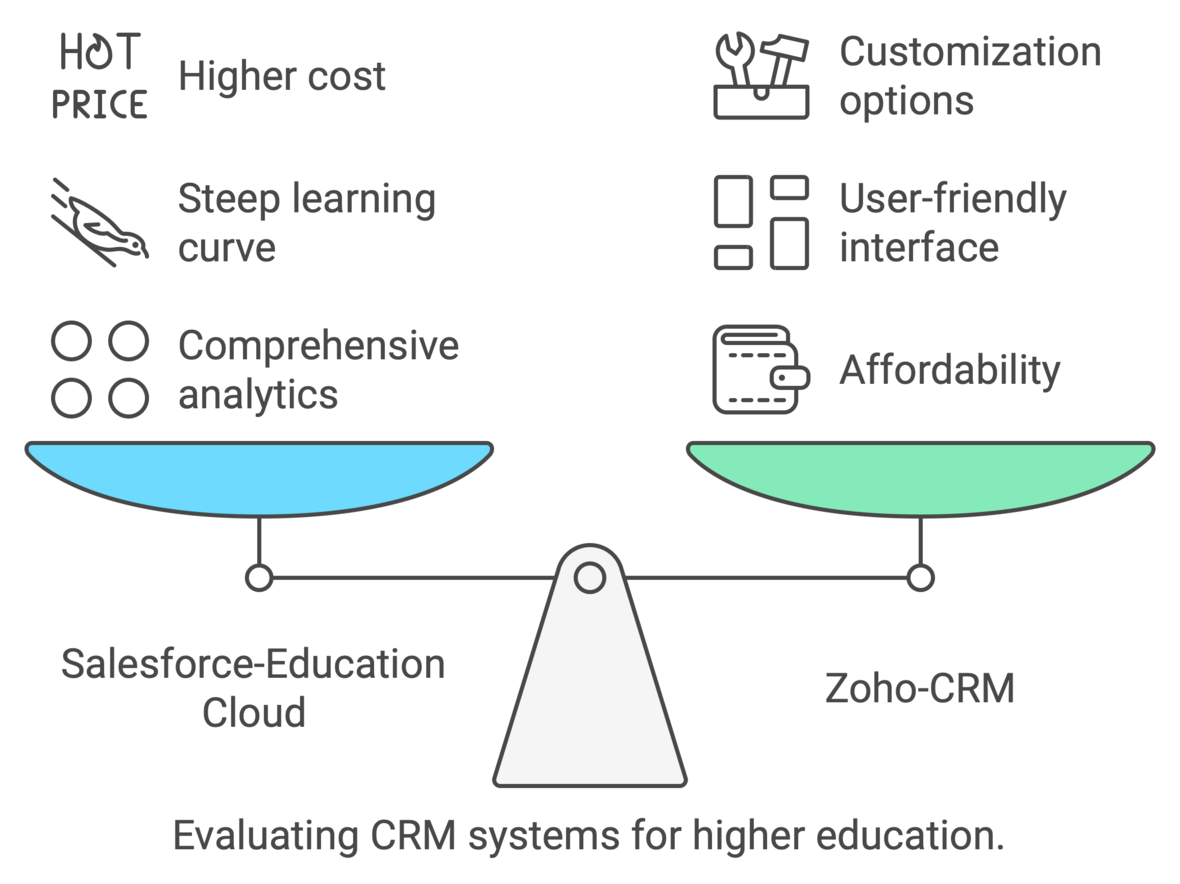
Oct 1, 2024
Higher Education CRM Software Comparison
In today’s tough education market, we must build student bonds and cut admin work. They are more important than ever. Higher education institutions are using a CRM software to meet these challenges. It is a powerful solution. But what exactly does CRM mean in the context of higher education? As universities seek new ways to recruit and keep students, they are turning to CRMs. These tools help build connections with students. These platforms automate communication, manage events, and analyze data. They have a robust set of features for academic institutions. Join us on an exploration of higher ed CRM software.
We will uncover its key functions, benefits, and implementation strategies. We will also compare popular CRM software platforms like Zoho CRM and HubSpot. Let’s explore how to use smart tech to boost your institution’s student engagement!
What is Higher Education CRM Software?
Higher Education CRM software is a specialized tool. It manages relationships between schools and their students. It helps at its core crm. It streamlines communication, boosts engagement, and personalizes experiences for students.
Higher ed CRMs differ from traditional CRMs used in other fields. They focus on the unique challenges faced by colleges and universities. They provide solutions for recruitment, admissions, student services, and alumni. Their work covers more, too. These systems allow institutions to track inquiries from prospective students.
They automate follow-ups via email and text campaigns. These platforms centralize data on students’ interactions with the school. They let admins make informed decisions. This boosts enrollment and improves student satisfaction. New technologies today can improve audience connections. Effective CRM solutions can help.
Understanding CRM for Higher Education
Higher Education CRM systems are made for colleges and universities. They meet their unique needs. They ease communication, optimize enrollment processes, and enhance student engagement. These platforms help institutions manage relationships with students and faculty.
They include prospective students, current learners, and alumni. By centralizing data, CRMs enable tailored marketing. It can resonate with diverse audiences. Understanding how these tools function is crucial. They streamline workflows by automating routine tasks like follow-ups and event management.
This not only saves time but also improves accuracy in tracking interactions. Analytics insights can help institutions improve their recruitment and retention strategies. In a world where personal connections matter, CRM for college admissions and higher education is vital. It helps foster strong relationships in the academic community.
Key Features of Higher Education CRM Systems
Higher education CRM systems are packed with features. They aim to boost student engagement and streamline admin tasks. One standout feature is the centralized database. It lets institutions manage all student interactions in one place. They can then personalize communication based on individual needs.
Another critical component is recruitment management tools. They help schools track prospective students from inquiry to enrollment. This ensures no chances are missed. Integration capabilities are also essential.
A strong CRM should connect with existing systems, like LMS and financial aid tools. This will give a complete view of each student’s experience. Analytics and reporting show trends and behaviors. They allow data-driven decisions to improve retention rates. Mobile access empowers staff and students. It provides real-time access anywhere, anytime. This connects everyone in today’s fast-paced world.
Benefits of Using CRM in Higher Ed
CRM systems offer many advantages for higher education institutions. They streamline communication between departments, ensuring everyone stays informed and engaged. These platforms boost student recruitment by automating follow-ups. This can greatly raise enrollment rates.
Colleges can now personalize their outreach. They can tailor messages to individual needs. CRM software aids in nurturing relationships with current students. It helps track academic performance and engagement levels, enabling timely interventions when necessary. Another benefit is improved data management. Institutions can analyze trends and make data-driven decisions that optimize resources effectively for every higher education institution.
Education CRM solutions often integrate with existing systems like LMS or SIS. This integration creates a seamless experience for both staff and students alike. With these tools, higher institution institutions can build stronger community ties. This will boost their success.

How to Choose the Best Higher Education CRM?
To choose the best Higher-Education CRM, know your institution’s needs. Start by identifying the key objectives you wish to achieve. Are you focusing on enrollment management, student engagement, or alumni relations? Next, consider user experience. An intuitive system for staff and students will boost usage and cut training time. Budget plays a crucial role as well. Assess not just initial costs but also long-term maintenance and update costs. Integration capabilities are another important factor.
Your CRM must connect with existing systems, like the LMS and financial aid services. It must be seamless. Don’t overlook customer support options from the vendor. Responsive support can make all the difference. It ensures your team gets help when needed, during implementation and beyond.
Tips for Selecting CRM Software for Higher Education Institutions
Selecting the right CRM software for higher education is crucial. Start by identifying your institution’s specific needs. Engage faculty and staff to understand their pain points. Next, test user-friendliness.
- Avoid complexity: A complex CRM system can lead to frustration for users. Opt for one with an intuitive interface that requires minimal training.
- Prioritize user-friendliness: Look for a CRM system that prioritizes ease of use. Users should be able to navigate and utilize the system effectively without extensive training.
- Consider integration capabilities: Ensure the CRM seamlessly integrates with existing systems, such as student information systems and financial tools. This will prevent data silos and improve workflow efficiency.
- Prioritize seamless data flow: The CRM should connect with other relevant systems to ensure a smooth flow of information and eliminate manual data entry.
Key Considerations When Choosing a CRM Solution
Choosing a CRM solution for higher education involves several important factors. First, consider the specific needs of your institution. What challenges are you facing? Understanding these requirements will help narrow down your options. Next, think about scalability.
Your chosen CRM should grow with your institution’s changing demands. Flexibility can greatly help as student populations and programs evolve. User-friendliness is essential too. An intuitive interface lets staff use the system with little training. Integration capabilities matter as well. Look for solutions that connect with existing systems, like learning or financial software. This will boost efficiency. Test customer support and resources offered by software providers. Strong help can reduce hurdles and improve user experience.
Comparing CRM Platforms: Zoho CRM vs. HubSpot CRM
For higher education software, Zoho-CRM and HubSpot are top CRM choices. Both platforms offer unique features tailored for academic institutions. Zoho-CRM stands out with its extensive customization options.
| Feature | Zoho | HubSpot |
|---|---|---|
| Pricing | Free tier available; paid plans start at $14/user/month | Free tier available; paid plans start at $20/user/month |
| User Interface | Customizable, but may feel complex for beginners | Intuitive and user-friendly, easy for beginners |
| Customization | High level of customization (modules, fields, workflows) | Customization available but more limited compared to Zoho |
| Automation | Advanced automation with workflows, macros, and blueprints | Automation available, with ease of setup for workflows |
| Third-Party Integrations | 500+ integrations with popular apps (G Suite, Microsoft) | Extensive integrations, especially with marketing tools and other HubSpot products |
| Analytics & Reporting | Customizable reports and dashboards, strong analytics | Built-in analytics, easy to use but less customizable |
| Mobile App | Available for iOS and Android, supports offline access | Available for iOS and Android, highly rated for ease of use |
| Scalability | Suitable for small to large enterprises with various pricing tiers | Ideal for small to medium businesses, scales well with HubSpot’s ecosystem |
| Support | 24/7 email and chat support, phone support with higher plans | Email, chat, and phone support; more personalized support with premium plans |
| Unique Features | Advanced sales forecasting, AI assistant (Zia) for insights | Built-in marketing tools, email tracking, and sequences; free CRM capabilities for small teams |
Your choice will depend on your institution’s priorities. Do you value deep customization or ease of use in engaging potential students?
What Are the Key Features of the Best CRM for Higher Education?
The best CRM software for higher education has essential, tailored features. They meet the unique needs of institutions. A centralized database is vital. It stores all student info and interactions in one place. User-friendly dashboards enable staff to check progress with minimal effort. This enhances communication among departments, fostering collaboration on student engagement initiatives. Another key feature is robust reporting and analytics tools. They let institutions track enrollment trends and assess recruitment strategies. They can use the insights to improve outreach efforts. Integration capabilities with existing systems are important as well. Connecting to LMS or financial software improves operations and user experience.
Also, personalized tools boost engagement by enabling targeted messages via email and SMS. This level of customization builds stronger relationships between students and the institution. Mobile accessibility allows users to manage tasks anytime, anywhere. It’s essential in today’s fast-paced education.
Essential Features of College CRM Software
When choosing college CRM software, some features are vital. They improve the student experience. First, robust communication tools with features like email integration and text messaging options ensure seamless interaction between students and staff and timely responses.
Next, a comprehensive database is crucial. It must track student data, from inquiry to enrollment. It should manage that data accurately. Analytics capabilities provide insights into student behavior and trends. Institutions can use this data to tailor their outreach strategies effectively.
Another vital feature is customizable workflows that help colleges find the best ways to customize admissions and event management to fit their needs. Mobile accessibility can’t be overlooked. A user-friendly app keeps students and faculty connected anytime, anywhere. It’s vital in today’s digital age.
Automation Tools and Event Management Features
Automation tools are revolutionizing how higher education institutions manage their operations. These features streamline repetitive tasks, allowing staff to focus on more strategic initiatives. With effective automation, admissions processes become seamless.
Automated emails and reminders ensure prospective students don’t miss deadlines or important info. This creates a smoother applicant experience while reducing administrative workload. Event management is another key component of modern CRM systems. Managing events like open houses, webinars, or alumni gatherings can be complex. A robust CRM simplifies scheduling and communication with attendees.
Event management tools can update in real-time and track RSVPs. This enhances engagement by keeping participants informed at every stage. The combination of automation and event management fosters greater collaboration among departments too. Teams now share information with greater openness. This improves planning and execution.
Security Features in Higher Education CRMs Systems
Security is a top priority for education institutions. With sensitive student data at stake, CRMs must have strong security. Encryption safeguards data both in transit and at rest. This means that even if hackers gain access, the information remains unreadable. User authentication protocols add another layer of protection.
- Multi-factor authentication is a crucial security measure to ensure that only authorized individuals can access sensitive records.
- Regular audits are essential for identifying and addressing potential vulnerabilities before they become security breaches.
- Regulations like FERPA (Family Educational Rights and Privacy Act) are vital for maintaining trust and integrity in handling sensitive data.
- Compliance with relevant regulations is paramount for organizations to demonstrate responsible data management and protect the privacy of individuals.
Also, role-based access controls let admins define who can view or edit specific info. This minimizes risks associated with unauthorized changes. These measures protect personal data. They also boost the institution’s reputation. They show a commitment to privacy and safety.

How Does CRM Software Implementation Work in Higher Education?
Implementing CRM software in higher education involves several critical steps. Initially, institutions must identify their specific needs and goals. This ensures that the chosen system aligns with organizational objectives. Next, a project team is assembled. This group often includes IT staff, admins, and faculty. They can provide insights into user needs. Collaboration among these stakeholders fosters a smoother transition. Once the system is selected, training becomes essential. Users need to become familiar with the new software to maximize its potential. Workshops and hands-on sessions are effective methods for facilitating this learning process. Data migration follows training. We must carefully transfer existing data from various sources. This is to avoid loss or corruption during this phase. Continuous support is crucial for troubleshooting any issues post-implementation. Regular feedback loops help refine processes. They also keep users engaged with the new system.
Steps for Successful CRM Software Implementation
Successful CRM software implementation begins with a clear strategy. Define your institution’s goals and understand what you aim to achieve with the CRM. This will guide the entire process.
Next, involve key stakeholders early on. Engaging faculty, staff, and even students fosters buy-in. It ensures all needs are met. Their feedback can be invaluable in shaping how the system is used. Training is crucial for effective adoption. Develop comprehensive training sessions tailored to different user groups within your institution.
Ensure they know how to use all features effectively. Data migration requires careful planning as well. Prepare existing data for the new system. Ensure accuracy and consistency in the transition. Check progress post-implementation regularly. Continuously gather user feedback. Adjust processes to boost efficiency and satisfaction with the new CRM platform.
Common Challenges in Implementing CRM Systems for Higher Education
Implementing a CRM system in higher education can be daunting. Institutions often face resistance from faculty and staff. They may be used to traditional methods. Another challenge is data integration.
Merging existing databases with new CRM software requires careful planning and execution. If not handled properly, it can lead to data inconsistencies or loss. Training personnel poses its own difficulties as well. Users need training for the system to work. It can strain resources and schedules.
Budget constraints are also prevalent. Many schools have tight budgets. It’s tough to fund comprehensive CRM-solutions. Customization demands attention. Each institution has unique needs that must tailored features within the CRM platform. Balancing these requirements against available options adds another layer of complexity during implementation.
Best Practices for CRM Implementation in Higher Ed
Successful CRM for education implementation in higher education hinges on clear communication. Involve all stakeholders from the outset, including faculty, administrators, and IT staff. This collaborative approach ensures everyone’s needs are addressed. Training is crucial.
Provide comprehensive sessions tailored to different user levels. A well-informed team can maximize the software’s potential and enhance user adoption rates. Data migration deserves careful planning. Assess existing data quality before transferring it into the new system. Clean data improves accuracy and usability right from the start.
Testing phases cannot be overlooked. Conduct pilot runs to identify issues early on. Feedback during this stage can refine processes before full-scale deployment. Rank ongoing support post-implementation. Regular check-ins with users help fix issues quickly. This keeps your CRM system efficient and effective for years.
Comparing Top Higher Education CRM Systems
When evaluating top CRM systems for higher education, several key players stand out. Each platform has features for the unique needs of colleges and universities. Salesforce-Education Cloud shines with its comprehensive analytics capabilities. It allows institutions to track student engagement effectively and tailor communications accordingly. Its robust reporting tools provide actionable insights that can drive decision-making. Zoho-CRM excels in affordability and customization options. It’s a great choice for small institutions wanting to scale their operations on a budget. The user-friendly interface simplifies onboarding processes for staff members. Choosing the right system depends on priorities, budget, and goals. No single solution fits all. So, it’s vital to understand these nuances to make an informed choice.
Salesforce Education Cloud: Pros and Cons
Salesforce-Education Cloud offers a robust solution tailored for educational institutions. Its integration with various platforms makes data management software easier. It helps track student interactions and outcomes. Its customizable features can be adapted to fit unique needs.
That’s a benefit. This flexibility allows universities to better recruit and engage students. But, some users find the learning curve steep. Navigating through diverse functionalities may must more training for staff members.
Cost is another consideration. Salesforce has powerful tools. But, smaller institutions may lack the budget for its platform. Despite these challenges, many are drawn to its support resources. This software includes tools that help optimize the user experience over time.
Zoho CRM vs. HubSpot CRM: Which is Better for Higher Ed?
For higher education, both Zoho-CRM and HubSpot-CRM are good options. They have strong features for institutions. Zoho-CRM is known for its affordability and extensive customization options. Institutions can change workflows easily, tailoring the system to fit specific requirements. Its reporting capabilities are impressive, providing valuable insights into student engagement.
- HubSpot CRM has a great UI and strong marketing tools.
- It excels at nurturing prospective students with targeted content.
- It facilitates personal outreach to engage leads effectively.
Both platforms integrate well with various applications but differ in pricing structures. Zoho is more budget-friendly and has great features. HubSpot may cost more for advanced tools. It depends on your institution’s goals and infrastructure. Knowing what matters most will help you make a good decision that meets your needs.
A Review of the Best CRMs for Higher Education
Selecting the right CRM can significantly impact an institution’s engagement and success. Several platforms stand out in the higher education landscape. Salesforce-Education Cloud excels with its robust customization options. It’s perfect for large universities. They need custom solutions to manage student relationships. Each system has unique strengths. They cater to diverse institutional needs. So, it’s crucial to test them when choosing the best fit.

What Are the Latest Trends in Higher Education CRM?
The landscape of higher-education CRM is evolving rapidly. Institutions are increasingly leveraging artificial intelligence to enhance student engagement and streamline operations. AI-driven analytics help universities predict enrollment trends and identify at-risk students more effectively. Another trend is the integration of social media in CRM systems. This lets institutions reach potential students where they spend time online. It creates a smooth, engaging communication flow with today’s tech-savvy generation. Cloud-based software solutions have also become standard, offering flexibility and scalability. These platforms let schools access data anytime, anywhere. This is vital for decision-making in today’s fast-paced world.
Personalized marketing campaigns powered by advanced segmentation tools like behavioral targeting and interest-based segmentation are on the rise. Tailoring messages to individual preferences boosts recruitment and strengthens ties with current students. The focus is shifting to improving user experience with school administration software. This requires tech solutions that meet the needs of schools.
Innovations in CRM Software for the Education Industry
The education sector is in a tech renaissance, led by CRM software. Innovative tools are emerging that enhance student engagement and streamline administrative processes. AI-driven analytics help schools understand student behaviors. This enables personalized communication strategies. This tailored approach fosters stronger relationships between students and staff.
Mobile capabilities have also improved significantly, allowing users to manage interactions on-the-go. In today’s fast-paced world, accessibility is key. It applies to tracking apps and text alerts.
Integration with social media platforms further enriches outreach efforts. Institutions can recruit students by engaging them where they’re most active online. This makes recruitment more effective than ever. Furthermore, the CRM provides automation features that ease event management and follow-ups seamlessly. This ensures no opportunity is missed and frees up educators’ time to focus on their core tasks: teaching and mentoring students.
Future of CRM Systems in Higher Education
The future of CRM systems in higher education is set to be transformative. As institutions embrace technology, CRMs will become more intuitive. They will enhance the user experience.
Artificial intelligence is expected to play a crucial role. Predictive analytics can provide insights into student behavior and engagement. It can help tailor communication strategies. Moreover, integration with other educational technologies will create seamless workflows. This means better data sharing between learning management systems and CRM-solutions. Mobile accessibility is becoming essential as well.
Students want instant access to information on their devices. So, developers must rank mobile-friendly designs. Data security and privacy concerns will drive stronger safeguards in these systems. Institutions must ensure student information remains protected while still utilizing valuable data analytics. As higher education institutions go digital, CRM systems designed specifically for higher education must adapt to new tech and learners’ needs.
Integration of Education Cloud and CRM Software
The merger of Education Cloud and CRM software is a big step for higher education. Merging robust data management with the cloud can help schools. It can streamline operations and improve the student experience. This fusion allows real-time access to critical data across departments. It fosters collaboration among staff. As schools become more dynamic, we must use these integrations to meet diverse needs. Institutions can use analytics to learn about students’ behaviors and preferences. This can improve recruitment and retention rates.
The smooth flow of information ensures that all decisions are well-informed. Schools must be adaptable. They should be open-minded about how to use these tools to maximize their impact on the community. With good strategies and strong CRMs like Salesforce or Zoho, there’s great potential. Education Cloud’s flexibility adds to it.

